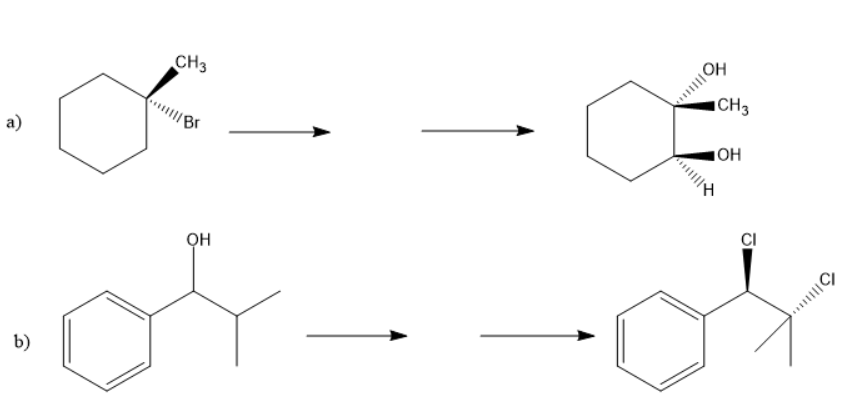Indicate what conditions would be required for each reaction shown below in order for the overall conversion to occur. Draw the intermediate product for each step.
Indicate what conditions would be required for each reaction shown below in order for the overall conversion to occur. Draw the intermediate product for each step.
Chemistry
10th Edition
ISBN:9781305957404
Author:Steven S. Zumdahl, Susan A. Zumdahl, Donald J. DeCoste
Publisher:Steven S. Zumdahl, Susan A. Zumdahl, Donald J. DeCoste
Chapter1: Chemical Foundations
Section: Chapter Questions
Problem 1RQ: Define and explain the differences between the following terms. a. law and theory b. theory and...
Related questions
Question
100%
Indicate what conditions would be required for each reaction shown below in order for the overall conversion to occur. Draw the intermediate product for each step.

Transcribed Image Text:This image appears to depict a two-part organic chemical reaction involving different compounds.
**Left Side:**
1. Starting Compound:
- Structure: A benzene ring attached to a two-carbon chain with a hydroxyl group (OH) and an isopropyl group.
- Notation: This compound is an aromatic alcohol.
2. Reaction Indicator: A downward arrow suggests a transformation or reaction is occurring.
3. Ending Compound:
- Structure: The benzene ring is now attached to a carbon with two chlorine atoms (Cl) and an isopropyl group.
- Notation: This indicates a halogenation reaction, where the original hydroxyl group is replaced by chlorine atoms.
**Right Side (a):**
1. Starting Compound:
- Structure: Cyclohexane ring with a bromo (Br) and methyl (CH₃) group attached.
- Notation: This is a bromo substituted cyclohexane.
2. Reaction Indicator: A downward arrow indicates another transformation or reaction.
3. Ending Compound:
- Structure: Cyclohexane ring with a methyl group and two hydroxyl groups (syn configuration), indicating an addition reaction leading to a diol.
- Notation: This structure suggests a reaction such as hydroboration-oxidation which typically results in syn stereochemistry.
These transformations suggest typical organic reaction proceedings such as substitution and addition reactions, fundamental concepts in organic chemistry.
Expert Solution
Step 1
Given reaction:

Step 2
The alkenes can be formed by dehydration of alcohols using dehydrating agent like sulfuric acid.
Alkenes can undergo addition reaction.
Step by step
Solved in 4 steps with 3 images

Knowledge Booster
Learn more about
Need a deep-dive on the concept behind this application? Look no further. Learn more about this topic, chemistry and related others by exploring similar questions and additional content below.Recommended textbooks for you

Chemistry
Chemistry
ISBN:
9781305957404
Author:
Steven S. Zumdahl, Susan A. Zumdahl, Donald J. DeCoste
Publisher:
Cengage Learning

Chemistry
Chemistry
ISBN:
9781259911156
Author:
Raymond Chang Dr., Jason Overby Professor
Publisher:
McGraw-Hill Education

Principles of Instrumental Analysis
Chemistry
ISBN:
9781305577213
Author:
Douglas A. Skoog, F. James Holler, Stanley R. Crouch
Publisher:
Cengage Learning

Chemistry
Chemistry
ISBN:
9781305957404
Author:
Steven S. Zumdahl, Susan A. Zumdahl, Donald J. DeCoste
Publisher:
Cengage Learning

Chemistry
Chemistry
ISBN:
9781259911156
Author:
Raymond Chang Dr., Jason Overby Professor
Publisher:
McGraw-Hill Education

Principles of Instrumental Analysis
Chemistry
ISBN:
9781305577213
Author:
Douglas A. Skoog, F. James Holler, Stanley R. Crouch
Publisher:
Cengage Learning

Organic Chemistry
Chemistry
ISBN:
9780078021558
Author:
Janice Gorzynski Smith Dr.
Publisher:
McGraw-Hill Education

Chemistry: Principles and Reactions
Chemistry
ISBN:
9781305079373
Author:
William L. Masterton, Cecile N. Hurley
Publisher:
Cengage Learning

Elementary Principles of Chemical Processes, Bind…
Chemistry
ISBN:
9781118431221
Author:
Richard M. Felder, Ronald W. Rousseau, Lisa G. Bullard
Publisher:
WILEY